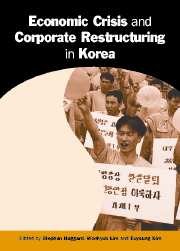Book contents
- Frontmatter
- Contents
- List of Figures
- List of Tables
- Preface and Acknowledgements
- Contributors
- A Note on Usage
- Abbreviations
- 1 Introduction: The Political Economy of Corporate Restructuring
- Part I The Politics and Economics of the Chaebol Problem
- Part II The Political Economy of Crisis Management
- 6 Business–Government Relations under Kim Dae-jung
- 7 The Restructuring of Daewoo
- 8 Bank-led Corporate Restructuring
- Part III Reform and Restructuring
- Index
7 - The Restructuring of Daewoo
Published online by Cambridge University Press: 05 July 2014
- Frontmatter
- Contents
- List of Figures
- List of Tables
- Preface and Acknowledgements
- Contributors
- A Note on Usage
- Abbreviations
- 1 Introduction: The Political Economy of Corporate Restructuring
- Part I The Politics and Economics of the Chaebol Problem
- Part II The Political Economy of Crisis Management
- 6 Business–Government Relations under Kim Dae-jung
- 7 The Restructuring of Daewoo
- 8 Bank-led Corporate Restructuring
- Part III Reform and Restructuring
- Index
Summary
Among the most frequent characterizations of the Korean economy are rapid growth, state-led industrialization, export-oriented policies and, since the Asian financial crisis, over-expansion, moral hazard, poor corporate governance, government bailouts and restructuring. The Daewoo crisis combines all these elements and underscores the importance of corporate reform for future economic growth.
Corporate reform of the top chaebol has been one of the nation's top priorities since the 1997 economic crisis. Daewoo, however, failed to comply with government reform efforts, and the government and creditors failed to force Daewoo's hand. The result was the biggest bankruptcy in Korean history, one that caused a serious setback in Korea's recovery. This chapter shows how and why Daewoo collapsed, and how Daewoo, its creditors and the government behaved during the crisis.
Although most chaebol in Korea followed a similar path of expansion based on borrowed money, Daewoo carried this strategy to the extreme. Kim Woo Choong, Daewoo's chairman, might also have believed in the myth of “too big to fail,” and overestimated his political influence. Daewoo's borrowing binge during 1998 did substantial damage to the already ailing giant, and by 1999 the group's collapse was unavoidable.
Creditor-led restructuring of Daewoo proved a “mission impossible” because creditors were squeezed by their own problems. Only the government could take the primary responsibility for Daewoo's restructuring. However, the Capital Structure Improvement Plan (CSIP) between Daewoo and its creditor banks and government limits on borrowing were half-hearted.
- Type
- Chapter
- Information
- Economic Crisis and Corporate Restructuring in KoreaReforming the Chaebol, pp. 150 - 180Publisher: Cambridge University PressPrint publication year: 2003
- 7
- Cited by



